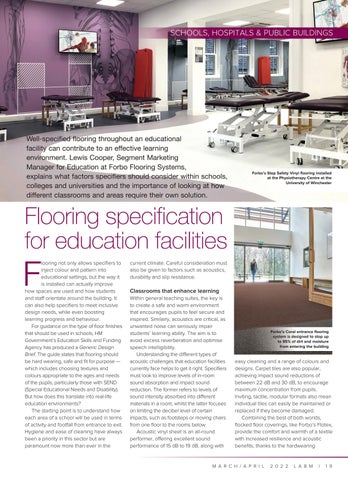019_LABM_MAR-APR22_Layout 1 22/03/2022 11:58 Page 19
SCHOOLS, HOSPITALS & PUBLIC BUILDINGS
Well-specified flooring throughout an educational facility can contribute to an effective learning environment. Lewis Cooper, Segment Marketing Manager for Education at Forbo Flooring Systems, explains what factors specifiers should consider within schools, colleges and universities and the importance of looking at how different classrooms and areas require their own solution.
Forbo’s Step Safety Vinyl flooring installed at the Physiotherapy Centre at the University of Winchester
Flooring specification for education facilities looring not only allows specifiers to inject colour and pattern into educational settings, but the way it is installed can actually improve how spaces are used and how students and staff orientate around the building. It can also help specifiers to meet inclusive design needs, while even boosting learning progress and behaviour. For guidance on the type of floor finishes that should be used in schools, HM Government’s Education Skills and Funding Agency has produced a Generic Design Brief. The guide states that flooring should be hard wearing, safe and fit for purpose — which includes choosing textures and colours appropriate to the ages and needs of the pupils, particularly those with SEND (Special Educational Needs and Disability). But how does this translate into real-life education environments? The starting point is to understand how each area of a school will be used in terms of activity and footfall from entrance to exit. Hygiene and ease of cleaning have always been a priority in this sector but are paramount now more than ever in the
F
current climate. Careful consideration must also be given to factors such as acoustics, durability and slip resistance.
Classrooms that enhance learning Within general teaching suites, the key is to create a safe and warm environment that encourages pupils to feel secure and inspired. Similarly, acoustics are critical, as unwanted noise can seriously impair students’ learning ability. The aim is to avoid excess reverberation and optimise speech intelligibility. Understanding the different types of acoustic challenges that education facilities currently face helps to get it right. Specifiers must look to improve levels of in-room sound absorption and impact sound reduction. The former refers to levels of sound intensity absorbed into different materials in a room, whilst the latter focuses on limiting the decibel level of certain impacts, such as footsteps or moving chairs from one floor to the rooms below. Acoustic vinyl sheet is an all-round performer, offering excellent sound performance of 15 dB to 19 dB, along with
Forbo’s Coral entrance flooring system is designed to stop up to 95% of dirt and moisture from entering the building
easy cleaning and a range of colours and designs. Carpet tiles are also popular, achieving impact sound reductions of between 22 dB and 30 dB, to encourage maximum concentration from pupils. Inviting, tactile, modular formats also mean individual tiles can easily be maintained or replaced if they become damaged. Combining the best of both worlds, flocked floor coverings, like Forbo’s Flotex, provide the comfort and warmth of a textile with increased resilience and acoustic benefits, thanks to the hardwearing
M A R C H / A P R I L
2 0 2 2
L A B M
I
1 9
















